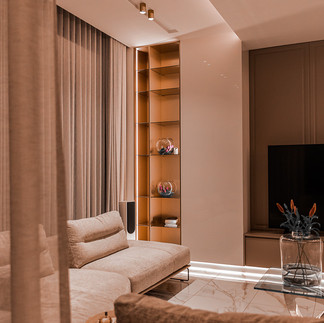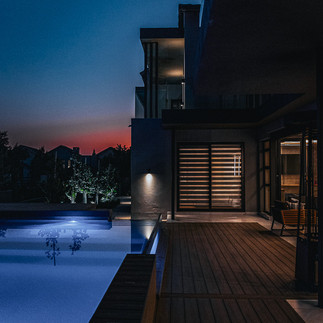Designing Interiors for Accessibility Without Sacrificing Style
- Theo Arewa-Bothma

- Jun 4
- 6 min read
How to Create Elegant, Accessible Interiors That Blend Luxury with Universal Design Principles
Design, at its highest level, is not just about what we see; it’s about how we move, feel, and live within a space. At Studio 8687, we believe that the most luxurious interiors are those that not only dazzle with beauty but serve with intelligence. And perhaps nowhere is that more vital than in the art of accessible design.
Imagine a villa in the Tuscan hills with panoramic views; seamless stone floors stretch from the indoor lounge to the outdoor terrace. No thresholds. No interruptions. Just flow. The elegance is unmistakable, but it’s what you don’t see that reveals the mastery: discreetly widened doorways, smart lighting that responds to motion, and a lift hidden behind bespoke oak paneling. This accessibility is done with intention and style.
Designing for accessibility is not about clinical installations or sterile finishes. It’s about empathy engineered into elegance. It’s about anticipating needs without compromising nuance. It’s a design that whispers rather than shouts, that includes without needing applause. And for the discerning homeowner; someone who values discretion, detail, and forward-thinking functionality, this is the new benchmark of luxury.
In this article, we explore how Studio 8687 approaches accessible interiors with the same creative precision we bring to every bespoke residence, from Parisian pieds-à-terre to coastal African retreats. Because true design doesn’t just accommodate, it elevates.
The Foundation of Seamless Movement, Space Planning with Intention
At the heart of any truly accessible interior is intentional space planning, a foundation that allows beauty and movement to coexist in perfect harmony. At Studio 8687, we see the floor plan as a kind of silent concierge, anticipating your every move and removing friction before you even notice it.
Wider doorways, softened corners, and open transitions aren’t concessions; they’re enhancements that elevate the entire spatial experience. Level flooring, whether polished micro-cement or seamless terrazzo, removes visual interruptions and tripping hazards, allowing materials to flow as effortlessly as the people who use them. And by strategically zoning key living areas; kitchens, lounges, guest suites, on a single level, we reduce reliance on stairs and create intuitive, lifestyle-driven layouts.
For our high-net-worth clients, this isn’t just about meeting needs; it’s about anticipating them with grace. How can effortless movement become a luxury in itself? Can these thoughtful features quietly boost long-term property value and allow you to age in place, beautifully? Properties like Aman Tokyo and the private villas at Singita Lebombo inspire us: each space feels expansive and tranquil, designed for all without drawing attention to its adaptability. This is what we mean by silent luxury, interiors that work hard without ever needing to explain themselves.
Materials That Marry Function and Sophistication
There’s a quiet confidence in a space that doesn’t need to announce its purpose. At Studio 8687, we believe that the true magic of accessible interiors lies in the materials, those tactile details that whisper elegance while working hard behind the scenes. When chosen well, materials not only elevate a room’s aesthetic but also support ease of use, safety, and durability in the most discreet ways.
In kitchens and bathrooms, we often lean into natural stone surfaces with honed finishes, elegant yet forgiving to touch, resistant to slips, and easy to clean. Cabinetry features soft-close mechanisms, touch-latch hardware, and integrated lighting that responds to motion or voice commands. These are not gimmicks; they are subtle enhancements that offer autonomy and comfort without visual clutter.
For our clientele, the question isn’t, “Will this be accessible?”, it’s, “Will this feel like me?” That’s where materiality does the heavy lifting. We consider how a leather-wrapped pull feels in the hand, how light moves across a textured wall, or how the warm tactility of a lime washed finish might soften a contemporary space. These choices aren’t just aesthetic; they’re intuitive, human, and deeply personal.
We often reference examples like Ilse Crawford’s work for Ett Hem in Stockholm, where luxurious materials serve emotional and physical comfort in equal measure. Or the interiors of Rose Uniacke’s London townhouse, where function is cloaked in a palette of aged wood, raw silk, and natural stone, an understated sensuality that feels quietly empowering.
Accessible design isn’t about compromise. It’s about curating an environment where every surface welcomes you, every texture guides you, and every element has a reason for being, visibly beautiful, and invisibly intelligent.
Adaptive Features That Blend into the Background
Truly exceptional design is invisible; it anticipates, adapts, and enhances without ever interrupting the experience. At Studio 8687, we see adaptive features not as add-ons, but as integrated expressions of thoughtful living. When done with care, adjustable-height counters, concealed lifts, and motorized systems become seamless extensions of the home’s personality; intelligent, beautiful, and almost imperceptible.
Elevators, too, have evolved. We often design vertical transport solutions that disappear into the architecture; paneled in timber, wrapped in fabric, or even integrated into existing stairwells. One recent residence featured a private lift cloaked in patinated steel that echoed the tones of a nearby art installation, more object than elevator. This is the hallmark of accessible luxury: features that work flawlessly without ever feeling imposed.
Technology also plays a powerful, silent role. Motion-activated lighting in hallways and bathrooms, voice-controlled window treatments, and smart security systems reduce reliance on manual effort. These are comforts for all, but particularly meaningful for residents or guests with physical limitations. Importantly, they also reflect a lifestyle of ease, something Studio 8687 clients value deeply.
As you walk through these homes, you don’t notice the tech or mechanics. You notice how everything responds; intuitively, effortlessly. It’s reminiscent of the design philosophy at The Chedi Andermatt in Switzerland, where modern Alpine minimalism meets hidden, high-performance functionality. Spaces adjust to the user, not the other way around.
This is where accessibility becomes art. It’s not just about inclusion; it’s about intuition. The home becomes an extension of its inhabitants, designed not just to impress but to serve.
Lighting, Acoustics, and Sensory Design, The Subtle Art of Comfort
Luxury is often defined not by what we see, but by what we feel. The way light falls across a space at dusk. The softness of silence in a well-insulated room. The instinctive calm that comes from a perfectly tuned environment. At Studio 8687, we design for all the senses because accessibility is not only physical, it’s emotional. And for our clients, true comfort is both seen and unseen.
Acoustics are just as critical. For clients with sensory sensitivities or hearing aids, overly reverberant rooms can feel exhausting. To address this, we incorporate sound-softening materials; plush rugs, upholstered wall panels, velvet drapery, and work with spatial volumes to reduce echo. One coastal villa in Portugal featured ceiling baffles wrapped in raw linen that complemented the pale oak interiors while subtly improving sound quality. The result? A home that sounded as gentle as it looked.
Tactility plays a profound role too. Think hand-troweled clay walls, silk-and-wool blends underfoot, and brushed limestone surfaces in wet rooms. These elements aren’t just about style; they’re about guiding, soothing, and anchoring the body through touch. They remind us that accessibility doesn’t stop at movement; it extends to every way we engage with the spaces around us.
We often look to hospitality spaces like the Sensei Lanai in Hawaii or the Fogo Island Inn in Newfoundland for inspiration, places where sensory richness and accessibility coalesce into deeply nourishing environments. These are not simply places to stay; they are places to feel whole.
By tuning a home to the full sensory experience, we elevate accessibility into something poetic. A home becomes more than a place to live; it becomes a sanctuary of ease, elegance, and quiet understanding.
At Studio 8687, we often say that good design listens before it speaks. It considers, anticipates, and adapts quietly, intelligently, and beautifully. Designing for accessibility isn’t about ticking boxes or responding to limitations. It’s about expanding the conversation. It’s about crafting spaces that serve a wider range of lives, bodies, and experiences, all while preserving the integrity of high design.
In truth, accessibility isn’t separate from luxury; it’s the evolution of it. A truly luxurious space doesn’t exclude; it embraces. It provides freedom of movement, clarity of use, and emotional comfort, all wrapped in material richness and architectural grace. It allows residents and guests alike to live with autonomy and ease, without ever compromising their lifestyle or aesthetic values.
Whether it’s a villa designed for multigenerational living, a city apartment subtly future-proofed for aging in place, or a hospitality-inspired retreat that soothes the senses, the principles remain the same: empathy, craftsmanship, and seamless integration.
Our hope is that, as you consider your next project, you’ll see accessible design not as an afterthought, but as a powerful, creative opportunity. Because when accessibility is embedded from the beginning, crafted with artistry, intention, and intelligence, it doesn’t subtract from style. It becomes style.













Comments